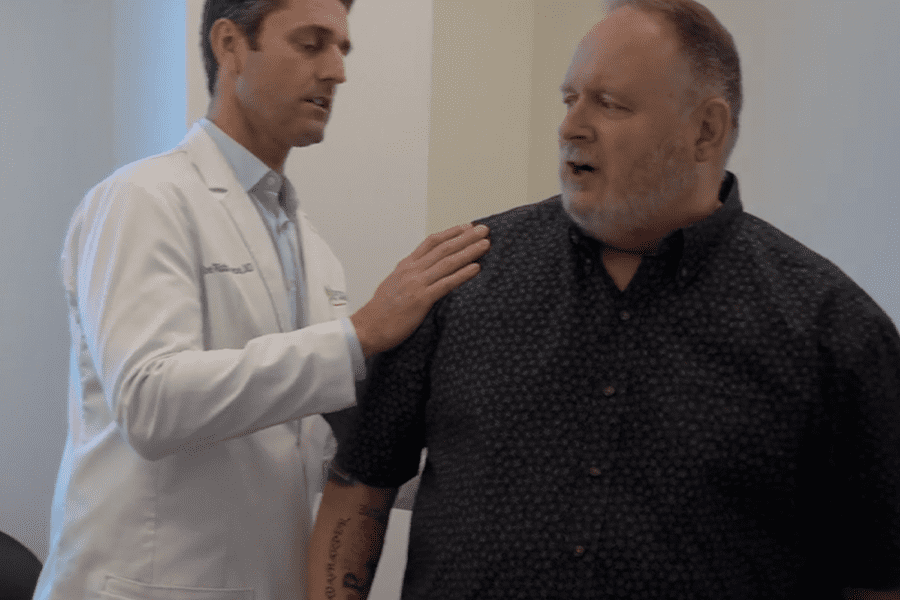- What is partial knee replacement?
- Why would I need a partial knee replacement?
- What’s it like to recover from partial knee replacement?
The knee joint takes a lot of hits as we go about our daily lives. It also plays a pivotal part in so many simple activities we take for granted, like taking a walk or standing up from a chair.
When this joint is damaged and in pain, it can severely affect your quality of life.
Before Michael’s partial knee replacement with Joseph W. Greene, M.D., board-certified orthopaedic surgeon at the Louisville Hip and Knee Institute, he lived in constant pain. Today he says, “I’m able to do some of the things I like doing and love to do, like travel. I’m right back at it.” Here’s his story.
What Is Partial Knee Replacement Surgery?
 A partial knee replacement is a surgery to replace a damaged portion of the knee joint. It’s a great alternative to a total knee replacement when only certain sections of the joint need repaired. The advantages of partial knee replacement over a total knee surgery include:
A partial knee replacement is a surgery to replace a damaged portion of the knee joint. It’s a great alternative to a total knee replacement when only certain sections of the joint need repaired. The advantages of partial knee replacement over a total knee surgery include:
- Minimally invasive
- Improved knee activity levels post-surgery
- Muscle sparing
- Less swelling and pain
- Quicker recovery times
- More natural feel
Partial knee replacement is also called knee arthroplasty. The surgery is highly precise and minimally invasive, with the goal of replacing the damaged part of the knee with a custom fitted prosthetic made of plastic and metal. Often patients say this surgery feels more “natural” afterwards because the healthy parts of the knee remain intact.
There are three major parts of the knee:
- The medial compartment, which is the inside of the knee
- The lateral compartment, or the outside of the joint
- The patellofemoral compartment, which is the front of the knee between the leg femur and your patella (kneecap)
There are two types of partial knee replacement available to doctors depending on the type of joint damage they suffer from:
- Unicompartmental partial knee replacement seeks to remove and replace only one compartment of the joint (medial or lateral)
- Patellofemoral partial knee replacement focuses on the patellofemoral section of the joint
Having a partial knee surgery was possible for Michael because only a portion of his knee was damaged. Like many patients, his outcome after the surgery was very positive. He says, “The knee is better than it’s ever been, so I’m completely happy.”
Why Would I Need a Partial Knee Replacement?
 In patients like Michael, non-surgical approaches no longer alleviated the crippling pain of arthritis affecting his knee. This is a typical reason for seeking a knee replacement. However, in many cases, a partial knee replacement surgery is all that is necessary because the arthritis or other damage affects only a section of the joint. Your doctor must carefully pinpoint the exact location of the damage to determine the best type of surgery to pursue.
In patients like Michael, non-surgical approaches no longer alleviated the crippling pain of arthritis affecting his knee. This is a typical reason for seeking a knee replacement. However, in many cases, a partial knee replacement surgery is all that is necessary because the arthritis or other damage affects only a section of the joint. Your doctor must carefully pinpoint the exact location of the damage to determine the best type of surgery to pursue.
Michael pursued relief with a prior orthopaedic surgeon and says he wasn’t pleased with the consultation. He says the doctor, “Took a look at the knee and said, ‘I think you’ve got a torn meniscus. No X-ray, no MRI, no anything.”
Michael decided to get a second opinion so he came to Dr. Greene. He describes his first visit with Dr. Greene, saying, “The first thing he said was, ‘We’re going to get you an MRI.’”
Michael did have a torn meniscus but the MRI also uncovered a stress fracture. Without the MRI, Michael says, “That was something we would’ve never known.” An MRI is an excellent tool for visualizing the areas of the knees that need repaired in some situations. In other patients, X-rays can give enough information. Your doctor should also check the range of motion and the stability of the knee as well as conducting a thorough analysis of your overall health.
If you are in good health and only a portion of the knee is damaged, like Michael, you may be eligible for a partial knee replacement.
What’s It Like to Recover From Partial Knee Replacement?
 Partial knee replacement is typically done as an outpatient procedure. Most patients leave the orthopaedic facility within two to three hours after their surgery, sometimes even on the same day. While each patient’s recovery is unique, the function of the knee should return relatively rapidly and with less pain than with a total knee replacement.
Partial knee replacement is typically done as an outpatient procedure. Most patients leave the orthopaedic facility within two to three hours after their surgery, sometimes even on the same day. While each patient’s recovery is unique, the function of the knee should return relatively rapidly and with less pain than with a total knee replacement.
For four to six weeks after the partial knee replacement, you will work closely with a physical therapist to learn strengthening exercises that help the knee heal. You’ll leave the hospital with instructions as well as medications to speed the healing process and help you manage pain. The typical patient returns to full activities within six to twelve weeks. It may take longer for your doctor to clear you for some sports. It depends on your goals and your individualized recovery process.
Michael healed quickly and well after his partial knee replacement with Dr. Greene. When asked about his recovery he says, “Some of the things I can do now that I hadn’t done before is walk. I can board planes and walk through airports. I’m able to get out and just walk with my grandchildren. They are the love of my life.”
Michael hadn’t realized how much his bad knee gradually curtailed his lifestyle. After the surgery he says, “I didn’t realize what I was missing. Just the simplest things that we take for granted. It’s great to have that mobility back.”
Here is another example of how an excellent orthopaedic experience can change your life. If you are currently suffering from knee pain and medications, physical therapy, or other treatments aren’t working, please don’t hesitate to call us. Together, we’ll find a solution and get you back to the activities you once enjoyed.

